More Woolston birds, mostly in moult (20 July 2003)
Another batch of Woolston photos to show that it certainly is all happening now (20 July), with birds at all states of plumage and moult, ranging from some youngsters only just out of the nest to adults that are not far off finishing their full moult. In the latter category, remember the very scruffy-looking Willow Warbler Phylloscopus trochilus that I posted two weeks ago? I caught him again, 13 days later, and the side-by-side comparison of wings allows a good appreciation of the speed of moult. He has advanced from a primary moult score of 19 (5 4 4 3 2 1 0 0 0 0) to 41 (5 5 5 5 5 4 4 3 3 2).
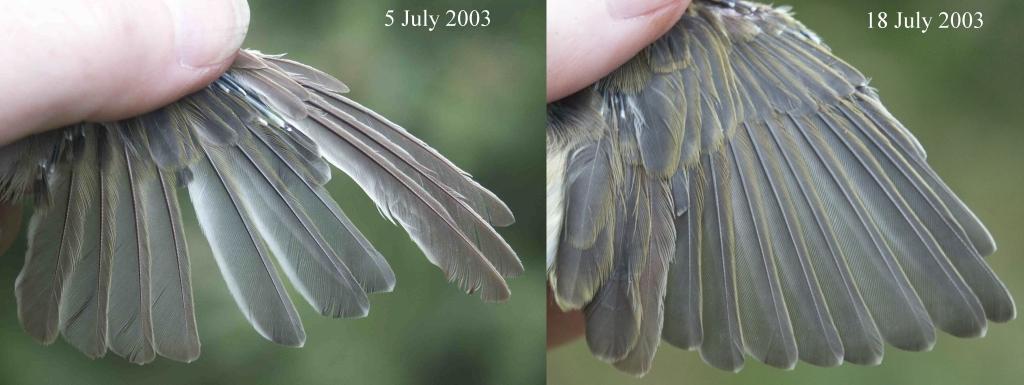
I e-mailed a copy of the first photo to Bob Mulvihill, my friend at Powdermill Nature Reserve, Pennsylvania - another moult-fanatic - and he replied with a delightful Americanism: "I'll see your ragged Willow Warbler and raise you one equally motley Yellow Warbler Dendroica petechia, a Powdermill bird just recaptured on 7/3 (3 July)! Interestingly, this YWAR's molt scores were virtually identical to your bird!" Those of you who look at the Powdermill website will already have seen the photo of his bird, but I thought I would show the side-by-side comparison of the two:
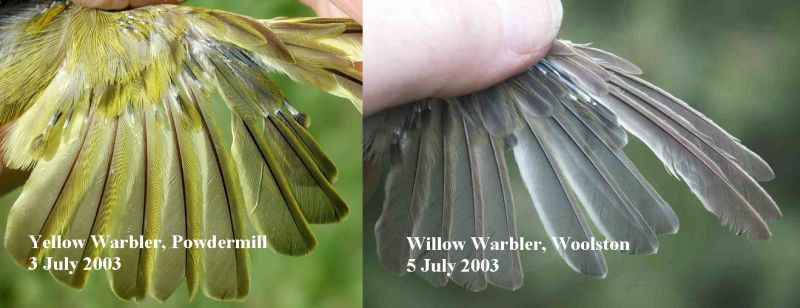
By contrast with this adult, well on with its full moult, this weekend I had the first juvenile Blackcap Sylvia atricapilla just starting its post-juvenile moult (below). It is about now that it normally becomes possible to start sexing them, as they start their head moult almost at the same time as they drop their juvenile greater coverts, but I thoroughly searched the head of this one and found no emerging quills, so I guess it had only just (within a few hours?) lost its greater coverts. Rest assured that in the next few weeks I'll try to capture a few images of moulting juvenile heads!
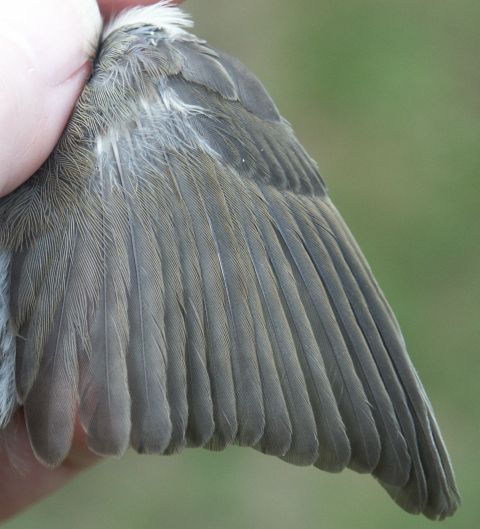
Whitethroat Sylvia communis is another species in which the adults moult after breeding and before migration; according to the BTO's 'Moult in Birds', the speed of their moult is similar to Willow Warblers, but one that I caught this weekend certainly wasn't moulting very intensely:
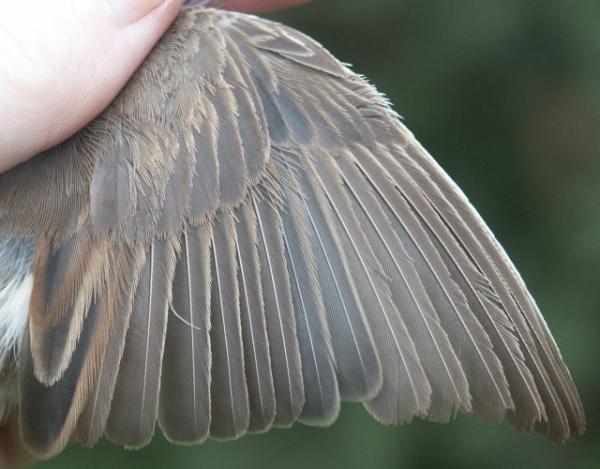
Using the standard moult scoring system, and counting all of the remiges, starting with the tertials and moving outwards, I would code this one as 5 0 5 | 0 0 0 0 0 0 | 5 4 0 0 0 0 0 0 0 0. Apart from the oddity that it has moulted the smallest and biggest feather of its tertials but not the middle one, the main point is that it is moulting very slowly, with only one growing feather, the second (from the inside) primary; I would almost guess that this bird will suspend (or arrest) its moult at that point.
Hirundines have just started roosting communally, giving the opportunity for a small catch (7 Sand Martins Riparia riparia and 40 Swallows Hirundo rustica) late on Friday to start the roosting season. Ageing and sexing is almost trivially easy, but I couldn't resist a comparison of the heads of a juvenile and an adult male:
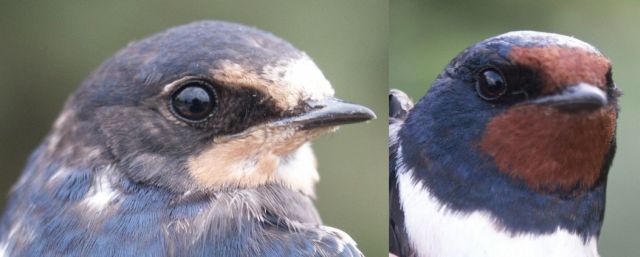
At the same time as catching them, a pipistrelle bat was in one of my nets:
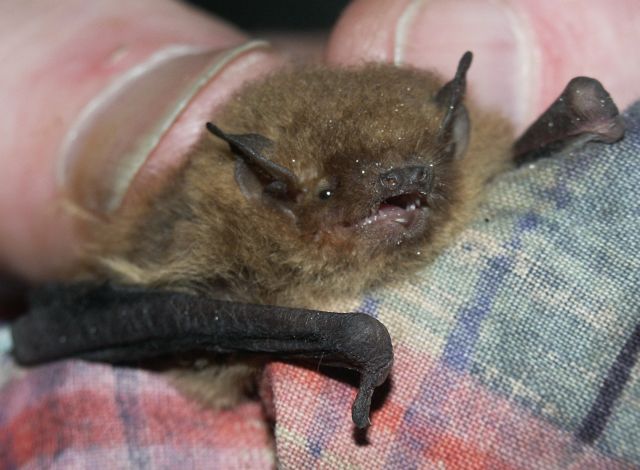
This photograph, taken with flash of course, is a pretty ungainly image but partly shows just how small they are. For scale, my thumbnail is about 16mm across; the forearm of the bat is about 30mm. I do not know very much about bat identification but I have an excellent guide called 'Which Bat is it?' written by Bob Stebbings, which I strongly recommend. It has an identification key, maps, black and white photos, text on conservation and even drawings of how to identify different species from the shape of their droppings! It is available, priced £3, from the Mammal Society: see their webpages at http://www.mammal.org.uk/publics.htm. However, please don't ask me which species of pipistrelle this one is! It is only in the last few years that bat specialists have realised that there are two British species, Pipistrellus pipistrellus and Pipistrellus pygmaeus, differing in the frequency of their echo-location calls, but I do not know how to separate them in the hand.
Finally, I attach a photo of the first Garden Warbler Sylvia borin that I have caught this year. They used to be much more common at Woolston - I caught 37 in 1988, the best year - and from 1980-90, 119 Garden Warblers were ringed and 374 Blackcaps, while from 1991-2002 the figures were 273 and 2979; the BLACA/ GARWA ratio across the reserve thus changed from 3.1 to 10.9. I assume that this is another reflection of the change from scrub to woodland in much of the site.
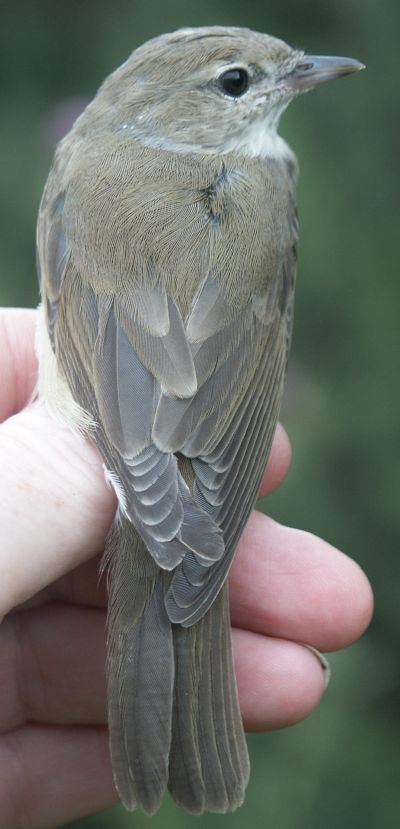
Back on the subject of moult, the Blackcap and Garden Warbler pairing makes an interesting comparison. Blackcaps, that moult here in autumn before migrating, take 45-50 days for their primary moult, while Garden Warblers, that fly to Africa then moult during our winter, take 65-75 days. Those species that moult here have to squeeze in a rapid moult before it gets too late for migration, while those that make it to Africa first can afford a much more leisurely moult. Sand Martins and Swallows are moulting primaries during most of the time they are in Africa (4-5 months) but they usually only have one or two feathers growing at a time, maximising their flying ability at all times - obviously important for species that feed on the wing.
David Norman.